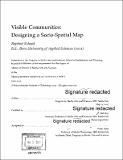Visible communities : designing a socio-spatial map
Author(s)
Schaad, Raphael
DownloadFull printable version (15.20Mb)
Alternative title
Designing a socio-spatial map
Other Contributors
Program in Media Arts and Sciences (Massachusetts Institute of Technology)
Advisor
Deb Roy.
Terms of use
Metadata
Show full item recordAbstract
This thesis presents a collaborative human-machine crowdmapping approach to creating socio-spatial maps that represent both spatial and social aspects of communities. Our implemented system combines satellite image analytics, a mobile mapping app, and social survey data. The system is designed to provide an end user experience that aligns institutional interests with grassroots interests, resulting in a self-sustaining system. In collaboration with the global health organization Partners in Health, we tested our approach with local health workers in Rwanda. Better maps can improve local visibility and empower communities to share knowledge, trade goods, and access medical services. Assisted by automatically annotated satellite maps, the community-driven mapping resulted in detailed spatial and social maps for four rural villages. With the collected data, we designed a novel socio-spatial map for this community that combines knowledge about household locations, paths, inhabitants of those homes, and social relations between residents. Generalizing from this map, we propose a framework to organize people, places, paths, and relationships to reason about the intersection of social and spatial mapping. Furthermore, we derive design characteristics of our human-machine mapping system that can guide the development of new systems in related contexts. Socio-spatial maps have the potential to be used as critical decision-making tools for individuals and organizations alike.
Description
Thesis: S.M., Massachusetts Institute of Technology, School of Architecture and Planning, Program in Media Arts and Sciences, 2017. Cataloged from PDF version of thesis. Includes bibliographical references (pages 90-96).
Date issued
2017Department
Program in Media Arts and Sciences (Massachusetts Institute of Technology)Publisher
Massachusetts Institute of Technology
Keywords
Program in Media Arts and Sciences ()